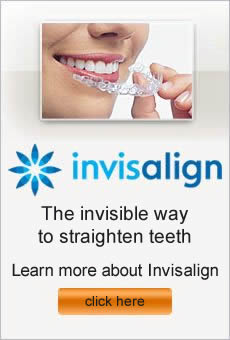As you check out orthodontic treatment for yourself or a family member, it’s important to make sure you have accurate information. Plenty of faulty ideas and folklore have been heralded as orthodontic gospel. Get your facts straight as you check out this list of common orthodontic myths:
Myth: I can have my family dentist straighten my teeth
Reality: Just like people visit a neurologist, not a family doctor, for issues relating to the brain, you should see an orthodontist to correct alignment and bite problems. Beyond regular dental school, orthodontists complete another two to three years of advanced training relating to the function and fit of teeth.
Myth: Only kids need braces.
Reality: A little less than 20 percent of orthodontic patients are 18 years or older. Not only will a straight smile look fantastic, but it also makes brushing and flossing easier, which can improve oral health.
Myth: I can download songs onto an iPod off signals from my braces that link to the Internet.
Reality: Though this would be a great selling point for young patients, it’s not possible at this time.
Myth: Orthodontic treatment takes two years and is very painful.
Reality: Braces aren’t one-size fits all. Treatment time depends on your specific case, ranging from a few months to a couple of years. As for discomfort, you may experience some initial soreness, but after the adjustment period, most people have few complaints.
Myth: All braces are ugly and embarrassing.
Reality: While traditional metal brackets aren’t the most appealing choice, newer options exist for less noticeable orthodontic treatment. Many kids and teens choose brightly-colored wires and brackets to add flare to their orthodontia. Adults who want to preserve their professional images may want to consider Invisalign clear braces, lingual braces that go on the back of the teeth, or ceramic brackets.
Mehdi Fotovat, DDS. Sherman Oaks California orthodontics – we care about you and your smile!
Although most people don’t love the idea of wearing braces, it doesn’t usually create any major problems. For some individuals, though, orthodontic treatment with braces is a bigger deal. Over time, some people develop sensitivity to nickel, a common metal found in jewelry, watches, and clothing. Unfortunately, nickel is a component in metal braces as well as in the wires and auxiliary pieces used during treatment.
Research indicates that more people have a reaction to nickel than to all other metals combined. This sensitivity occurs when the immune system responds to the foreign substance. More females than males exhibit problems with nickel, which may be attributed to other contact with nickel such as with watches, earrings, metal buttons, and even detergent. Symptoms may include a rash on the skin and lesions in the mouth.
One of the reasons for the increase in nickel sensitivity cases is the popularity of body piercing. The jewelry used for these piercings usually contains nickel. While the initial exposure to the nickel may not cause a reaction, full symptoms may develop with subsequent exposure.
If you or a loved one has sensitivity to nickel, talk with your orthodontist about other options. Often, stainless steel components, which are only about eight percent nickel, will work better than other metal appliances. Ceramic, plastic, gold-plated, and titanium brackets are other alternatives to consider as well as Invisalign. In some cases, a reaction may not develop until after treatment has started. Contact your orthodontist right away if you notice any signs of nickel sensitivity.
We love to see you smile at our orthodontic dental practice in Sherman Oaks, CA – Mehdi Fotovat, DDS
The American Association of Orthodontists (AAO) recommends that children receive an evaluation around age seven. Not all children will need early treatment, but it’s important to have an orthodontist see how things are developing. Certain problems are easier to correct at an early age, so this initial assessment helps set your child on the right path. As well, your orthodontist can assess your child’s development and make sure everything continues on the right track.
Around age seven, your child’s first molars appear, which solidifies the back bite. At this time, the orthodontist can see how the various teeth are in relation to the others, looking for issues such as overbites, crowding, or crossbites. Without correction, orthodontic problems can result in uneven tooth wear, speech impediments, and greater risk of decay or gum disease.
For some children, it’s particularly important to schedule an early evaluation. If you notice the following problems, contact the office of Mehdi Fotovat for an appointment:
• Breathing through the mouth
• Clenching or grinding
• Crowding
• Difficulties with speech
• Extended use of a pacifier
• Spacing problems
• Thumbsucking beyond preschool
Bringing your child to the orthodontist for an early assessment means addressing these issues, or others like them, before they create additional problems. Early treatment can make room for permanent teeth that still need to erupt and also lessen the time needed in braces at a later point. Often, therapy is most successful when treatment is performed while the jaws and face are still growing.
Schedule a Visit to our Sherman Oaks orthodontic practice and see how we can enhance your smile. Mehdi Fotovat
In recent years, more kids and adults are wearing braces. Research indicates that 70 percent of the population could benefit from orthodontic treatment. Based on fossil findings, our ancestors had little trouble with alignment of their teeth, so what happened to us? As different ethnic and genetic populations began to merge, human growth pattern in the mouth didn’t accommodate teeth and jaw development.
Often, children inherit the need for orthodontic from one or both parents whose teeth didn’t align correctly, just as you inherit eye color or seasonal allergies. These tendencies can be passed down from generation to generation. Consequently, your child’s teeth may be too large or too small for the jaw area, resulting in crowding or extra spaces.
With modern orthodontic treatment, your orthodontist can correct alignment and spacing problems. Generally, it’s a good idea to bring your child in for an orthodontic evaluation around age seven. At this time, the orthodontist can assess your child’s current and future development to determine if any intervention is necessary. Some children require Phase I, or early orthodontic treatment, to prepare their mouths for Phase 2, the straight-forward phase of treatment that usually involves traditional braces.
If you would like a straighter smile, but never made steps to change it, there’s still time. Even adults can benefit from orthodontic treatment. With modern alternatives like Invisalign clear aligners or ceramic braces, you can achieve a picture-perfect smile without the hassle and embarrassment of metal braces.
We’ll give you something to smile about at our Sherman Oaks, CA orthodontic practice – Mehdi Fotovat, DDS.
If you have braces, you visit the orthodontist on a regular basis. Orthodontics is one of several recognized dental specialties. Even though most people have heard of braces, they may know little else about the field of orthodontics. Expand your knowledge and impress your friends with these factoids:
Did you know that…?
• Orthodontists must complete four years of dental school and an additional two years of graduate training before they can practice.
• The first certified orthodontist in the United States was Dr Charles Tweed, who devoted himself to this area of study for 42 years.
• In 1728, Pierre Fauchard designed the first braces, which consisted of a flat strip of metal connected to teeth by pieces of thread.
• Edward Angle invented orthodontic brackets in 1915.
• As early as 400 BC, Hippocrates wrote about issues with “irregularities of teeth.”
• The ancient Greeks combined base metals and *cat gut* to improve smiles around 1000 B.C.
• Although metal brackets and wires were the original form of modern braces, options like clear brackets, lingual braces, and Invisalign clear aligners are now available as well.
• Many teen patients have turned their braces into fashion statements with colored bands and brackets.
• Celebrities, models, and athletes want straighter teeth too. Tom Cruise, Brett Farve, Chelsea Clinton, and Gwen Stefani are a few famous faces that have worn braces.
• You’re never too old to enjoy a healthy smile. In fact, an estimated 1 million Americans over age 18 have decided on orthodontic care to straighten their teeth.
It’s time to schedule your visit to our Sherman Oaks CA orthodontic office. Dr. Fotovat – Burbank Orthodontist – WebBraces.com



